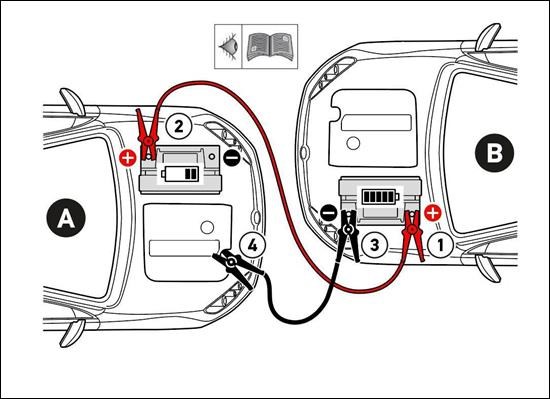"Starting aid" repair notes - Jump starting using jumper cables | HELLA
"Starting aid" repair notes
Jump starting using jumper cables
If the starting speed of a motor vehicle is not sufficient to start the engine due to a weak battery, the vehicle can be started externally using an external battery and jumper cables. In the majority of cases, the procedure ─ also known as "bypassing" ─ is performed with a second vehicle and jumper cables.
If no nearby breakdown service is available, the following should be observed when starting a vehicle with jumper cables:
- To avoid damage to the vehicle electrical system, only use suitable jumper cables with sufficient wire cross section
- Carefully read the operating instructions for the jumper cables and the vehicles ─ including the safety notices ─ before jump starting
- The batteries of both vehicles should have the same rated voltage
- If the starting aid is to be used in conjunction with another vehicle, please make sure that there is no contact between the bodywork of the two vehicles
The current-supplying battery should be adequately charged and have a capacity (Ah) that is identical to or greater than that of the dead battery

Safety notice!
- To prevent any kind of material damage or personal injury, no starting aid should be used if batteries are frozen, damaged or leaking!
- Do not jump start in environments where there is a risk of explosion!
- There is a risk of fire, deflagration, corrosion and explosion if the jumper cables are used improperly on the vehicle!
Preparing to use the starting aid
- Vehicles must be secured to prevent unintentional rolling away
- With automatic transmissions, engage the gear position "P" and pull on the parking brake
- With manual transmissions, keep the gear lever in the neutral position and pull on the parking brake
- Before commencing work with the starting aid, switch off all current consumers such as the radio, ventilation/air-con and the "ignition" on both vehicles
Connecting the jumper cables
In this context, it is important to always carefully observe information on the subject of "Starting Aid" in the operating instructions for each vehicle!
- Connect clamp 1 of the red jumper cable to the positive pole of the current-supplying battery (B).
- Connect clamp 2 of the red jumper cable to the positive pole of the dead battery (A).
- Connect clamp 1 of the black jumper cable to the minus pole of the current-supplying battery (B).
- Connect clamp 2 of the black jumper cable as far away from the battery pole as possible to the ground connection/body or engine block of the vehicle (A) with the dead battery.

A = vehicle with dead battery/B = vehicle with current-supplying battery
Important notes!
- The black cable must not be connected to the minus pole of the dead battery in the vehicle receiving the charge. Exercise caution with gas-generating batteries ─ there is a risk of explosion!
- In the case of vehicles with battery management systems, the starting aid has to be used in conjunction with the jumpstart connection points in the engine compartment. If the starting aid is used directly on the battery poles, damage can be done to the electrical system or to the battery sensor.

Image
Position of jumpstart connection points
BMW/E90 in engine compartment
Jumpstarting
- Start vehicle (B) with the current-supplying battery and run at idle speed
- Start vehicle (A) with the discharged battery
- If the vehicle does not start, take a break of at least 1 minute after each start attempt, which should not last longer than 15 seconds. When the vehicle has started, wait approx. 2 minutes for the engine to run smoothly before disconnecting the jumper cables

Disconnecting the jumper cables
Disconnect the jumper cables in reverse order.
- Disconnect clamp 2 of the black jumper cable from the vehicle with the dead battery
- Disconnect clamp 1 of the black jumper cable from the vehicle with the current-supplying battery
- Disconnect clamp 2 and then clamp 1 of the red jumper cable
Note!
After a successful jump start, the vehicle should first be driven around for some time to recharge the battery.
To prevent further vehicle breakdowns, the vehicle battery should be recharged using a charger and checked afterwards, or be replaced if this is necessary.
Important safety note
Technical information and practical tips have been compiled by HELLA in order to provide professional support to vehicle workshops in their day-to-day work. The information provided on this website is intended for use by suitably qualified personnel only.
Reprinting, distribution, reproduction, exploitation in any form or disclosure of the contents of this document, even in part, is prohibited without our express, written approval and indication of the source. The schematic illustrations, pictures and descriptions serve only for the purposes of explanation and representation of the instructions and cannot be used as a basis for installation or assembly work. All rights reserved.
Not helpful at all
Very helpful